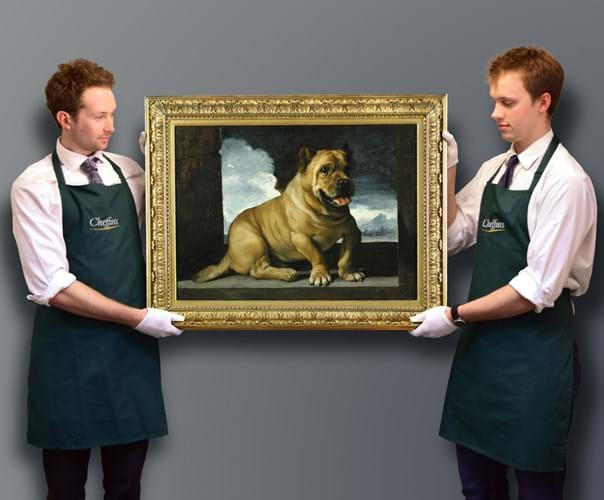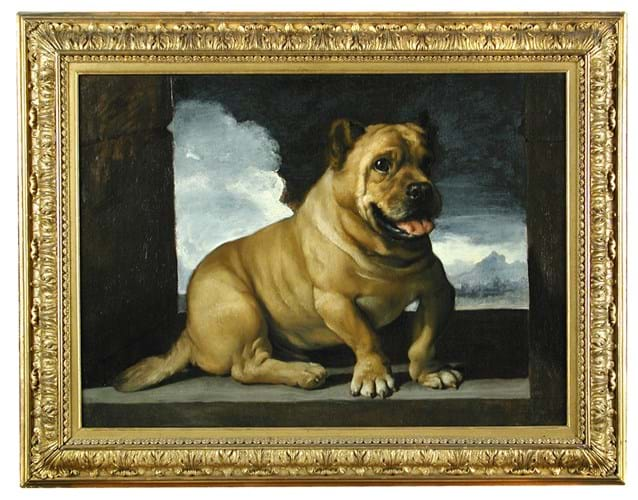
Important Old Masters by major names in art history – especially with canine subjects – are not the kind of pictures that frequently appear at a regional sale. But this oil on canvas is an example of a fascinating work emerging from the provinces (in this case Suffolk) where, following research, an attribution has received academic approval from a number of leading scholars.
Here are seven reasons why this painting represents such an exceptional consignment.
1. The Artist
Giovanni Francesco Barbieri became known as Il Guercino (Italian for ‘squinter’) because he was reputedly cross-eyed. Born in Cento, near Ferrara, he was largely self-taught and rose to become one of Italy’s most celebrated artists of the day. He was summoned to Rome by Pope Gregory XV in 1621 where he received a series of commissions for altarpieces and frescoes.
Major works by Il Guercino do not become available very often. The auction record for the artist stands at £5.19m (including premium) which was set when Christie’s sold the painting King David at an evening sale in London in July 2010.
2. The Subject
Most of Il Guercino’s paintings that have appeared on the market in the last 20 years have biblical or classical subjects. This painting could not be more different. It depicts an Italian mastiff in a mountainous landscape – while dogs feature in other Guercino paintings this example is one of very few works where the artist focused solely on an individual animal.
The only other known canine portrait is Portrait of the Aldrovandi Dog which sold at auction in the 1970s and is now in the Norton Simon Museum in Pasadena, California.
3. The Breed
The robust physique and head of the dog indicate that the subject of the Cheffins painting is a ‘Cane Corso’, an ancient breed praised by the Romans for their courage and strength, and a progenitor of the modern Italian mastiff which is still favoured as guard dogs today.
This opinion is shared by both the Kennel Club of Great Britain and its Italian counterpart, the Ente Nazionale della Cinofilia Italiana.
4. The Attribution
While the execution and composition point to the Italian Old Master, Il Guercino’s authorship of this work has now been endorsed by Dr Nicholas Turner, an authority on the artist’s work, and by John Somerville, senior curator of the Lobkowicz Collection, Prague.
It has also been confirmed by the Italian art historian, Dr Francesco Petrucci, who has requested it for his forthcoming exhibition Cani in Posa at La Veneria Reale in Turin in October.
5. Provenance
The emergence of ‘Study of an Italian Cane Corso’ is being billed as a classic ‘rediscovery’ story. It was bought by the vendor’s great-grandfather in Rome in 1850 and has resided in a Suffolk country house for the past 167 years. Before its consignment to auction, it was previously unknown to scholars.
6. Condition
According to the auctioneers, the 22in x 2ft 6in (56 x 76cm) oil on canvas is in largely original condition and has not undergone any major restoration.
Many Old Masters of this age have had extensive work carried out which, unless sensitively done, can significantly detract from its commercial appeal. Cheffins told ATG that this painting had only had a light clean.
7. Artistic merit
The style of the work at Cheffins points to a date of around 1625-30 which was something of a transitional period for Il Guercino.
The rapid brushwork for the dog’s honey-coloured coat indicates the artist adopted free handling for this work and it has even been suggested he used the pointed wooden end of the brush in the wet paint for the producing the effect of the rolls of flesh at the subject’s neck.
Dr Nicholas Turner said: “The personality of the dog is so beautifully observed and conveyed, it is tempting to suggest that it was the artist’s own animal, but even if not, then one which he admired, bonded with and indeed very evidently loved.”






